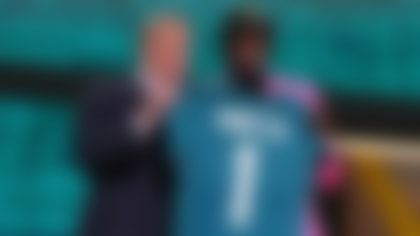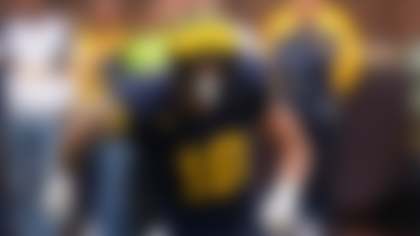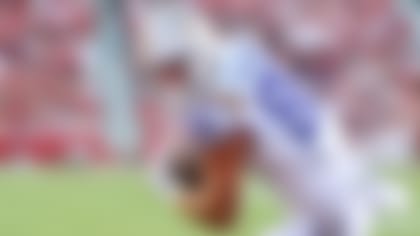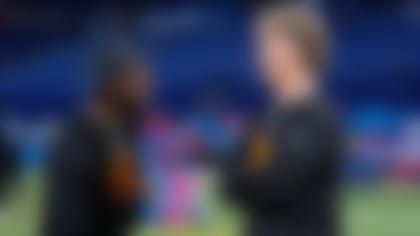NEW YORK -- What one thinks about the New Orleans Saints' "bounty" program and its aftermath could come down to whether one speaks the language of the NFL or the players.
The league has faced harsh criticism for failing to publicly divulge evidence that suspended Saints players participated in a scheme in which they promised and were paid financial bonuses for injuring opponents. The league apparently tried to rectify that situation Monday, with NFL lead counsel Jeff Pash showing evidence to a dozen members of the media, including myself.
This came as New Orleans linebacker Jonathan Vilma (suspended for the entire 2012 season), defensive end Will Smith (suspended four games) and ex-Saints Scott Fujita (three games) and Anthony Hargrove (eight games) ventured to New York to appeal their punishments in front of Commissioner Roger Goodell. Based on comments made by Vilma and Fujita, the players didn't seem to be buying much of the league's case.
The NFL has evidence that there was a pay-for-performance program in place. However, based on what I saw Monday, it's hard to say that the evidence proves definitively that players were rewarded for intentionally targeting opponents for injury. The players, who left the appeals hearing without really defending themselves to Goodell, argued they weren't part of a "head-hunting" program. The league noted that while players might not have targeted opponents for illegal hits, they funded and pledged to reward teammates for injuring players.
The evidence the league provided was fairly compelling, and seemed to support its argument. The NFL Players Association released the evidence given to it by the league, and claimed on its website that the league's evidence doesn't mesh with evidence it collected during its own investigation.
The media heard and saw evidence collected from computers in the Saints' facility. That was a fingerprint. Former defensive coordinator Gregg Williams and current assistant coach Joe Vitt also were outed for providing testimony about a pay-for-performance program when interviewed by league investigators. Other sources were cited by the league, although not divulged.
The league said Williams admitted there was a bounty program, that Williams, Vitt and some players "voluntarily" funded it and it was spearheaded by Williams. Williams started the program upon his arrival in 2009 and pushed it through to players after consulting with defensive captains Smith and Vilma, who, the league said, also contributed "seed" money to get the bounty pot in place.
Williams, who was banned by the league indefinitely for his actions, was such a cooperative witness that he told the NFL he was "rolling the dice with player safety and someone could have been maimed."
That is a huge admission that got the attention of the league. It should get the attention of everyone involved, including teams that faced the Saints. Williams' frankness about the program he ran -- especially in light of how Saints players and other players have stood up for him -- could hurt the other players' ability to trust him, should he ever get the chance to coach again.
Williams' admissions clearly help the NFL's case, though, especially since he also admitted that he was the mastermind of the program.
The question isn't whether players, coaches or marketing agent Mike Ornstein, a good friend of coach Sean Payton (who was himself suspended for the season), put money into a kitty to reward players for big plays. At least based on what we were shown, it seems like there was a program in place; based on statements from Williams, Vitt (who was suspended for six games), Payton and general manager Mickey Loomis (suspended for eight games), there was an acknowledgement that something wrong was going on.
The question, however, is whether players intentionally tried to hurt other players. The only player cited for receiving a "cart-off" reward was safety Roman Harper, who injured New York Giants running back Brandon Jacobs on a legal hit and, according to documents, was scheduled to be paid $1,000.
Harper was not among those disciplined, though. According to the league, the disciplinary focus was on Vilma, Fujita, Smith and Hargrove because they were leaders. That's why, despite claims that investigators reviewed more than 18,000 pages of evidence, the league used roughly 200 pieces of evidence to target those four, league security and lawyers said.
ATL: Vilma a man alone
Jonathan Vilma is aggressively challenging how the NFL handled its investigation into the Saints' "bounty" program. Gregg Rosenthal writes about the solitary nature of Vilma's struggle. **More ...**
Much of the other evidence focused on other players and coaches. Information kept on team computers detailed payments that were made into a pot. The evidence detailed players who owed back money, players whose mistakes cost them more money and players who had been rewarded for big plays. The information didn't make the players -- or the coaches involved -- look very good.
One piece of evidence showed that Saints players had pledged $35,000 to anyone who could knock Minnesota Vikings quarterback Brett Favre out of the 2009 NFC Championship Game. Vilma, according to the document, pledged $10,000. Hargrove, on a subtitled video, is seen winking, then telling teammate Bobby McCray to give him his money after Vitt told players it appeared Favre had broken his leg and wouldn't return.
Was the money ever paid or collected? The league did not have solid answers on that, but representatives did say it has credible testimony that money was collected and held in a safe in Williams' office, then paid out to players weekly if they did what was required to earn it.
There also was a slide of a motivational post shown to players before a 2010 playoff game with the Seattle Seahawks. Photos of quarterback Matt Hasselbeck, wide receiver Mike Williams, running back Marshawn Lynch, and someone in a sniper scope's crosshairs were included, as were motivational messages. There was a picture of reality show celebrity Duane Chapman, otherwise known as "Dog The Bounty Hunter," and the message read, "Time to do our job ... collect bounty$$$."
Brandt: Saints will contend in 2012
Despite all the offseason turmoil, the Saints made a huge impression on Gil Brandt with focused team workouts. **More ...**
That slide came from a computer in the Saints facility and was, according to the league, corroborated by testimony from other sources.
According to Pash, Goodell really wanted to hear from players, who declined to be interviewed before their punishments were doled out. That's why Goodell has given players and their lawyers until the end of business Friday -- and maybe longer -- to argue their cases and state why he should reduce their punishments.
Based on comments made over the past few days, weeks and months, the players, their lawyers and the NFLPA seem to feel it's unfair that Goodell gets to judge them, discipline them and hear appeals. However, they agreed on Goodell's ability to take on those roles in the collective bargaining agreement signed last year.
Players could attempt to plead their cases in the court system. Vilma has already sued Goodell for defamation; unlike the other players, he's sought his own counsel. He didn't bother to hear the NFL's case on Monday, leaving the hearing early.
Something seemed to have been going on in New Orleans, based on what we saw. Were the players' actions as heinous as they've been portrayed? That is difficult for me to say. But this isn't going to end anytime soon, and it's hard to think there will be any winners when it eventually does.
Follow Steve Wyche on Twitter @wyche89











